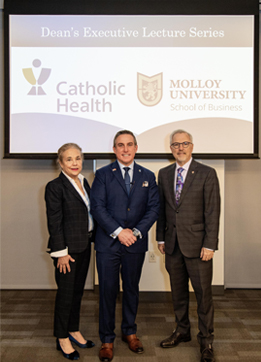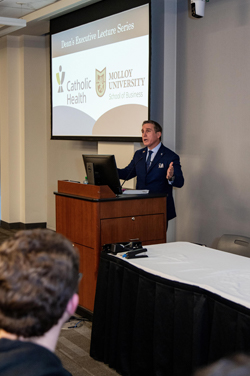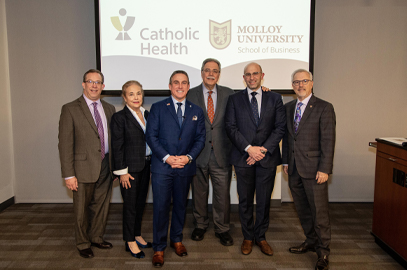March 30, 2023
Dean’s Lecture Series: Well Care Has Key Role in Keeping People Healthy
 The President and CEO of Catholic Health, Patrick M. O’Shaughnessy, D.O., delivered the third Molloy University School of Business Dean’s Lecture on March 23 in the Barbara H. Hagan School of Nursing and Health Sciences.
The President and CEO of Catholic Health, Patrick M. O’Shaughnessy, D.O., delivered the third Molloy University School of Business Dean’s Lecture on March 23 in the Barbara H. Hagan School of Nursing and Health Sciences.
The lecture series spotlights highly accomplished, visionary, and internationally recognized business leaders. His topic was “The Changing Landscape of Health Care and the Future Outlook.”
He addressed business and health care students saying that the cost of health care provided is out of balance with the rate of reimbursement for such services. The wide disparity in the figures will not be sustainable going forward, necessitating a different approach, said Dr. O’Shaughnessy.
Along with providing the “best of sick care,” Dr. O’Shaughnessy said health care professionals must make “well care—and treating to keep people healthy” a priority. “We don’t do that, on the whole,” he said.
He was introduced by Molloy University President James P. Lentini, D.M.A., who recalled first meeting the doctor at Catholic Faith Network at the outset of his own presidency two years ago. “That turned into the start of a nice collaboration between our two institutions,” Lentini said. 
Gioia Bales, the dean of the School of Business, said that Molloy and Catholic Health both “have a strong sense of mission in the Catholic tradition.” She mentioned serving on a monthly joint committee with those from Molloy and Catholic Health to further the strong relationship between the two.
Before being selected to head Catholic Health in 2021, Dr. O’Shaughnessy spent many years as a physician serving in the emergency room of the system’s hospitals. Much of what he witnessed about how such emergency rooms are used, and by whom and why, informed larger points he made during a fast-paced, nearly hour-long lecture.
At the outset, he gave a rundown of some current Catholic Health numbers on Long Island, such as more than 1,900 hospital beds at six acute care hospitals, three nursing facilities, 82,500 annual hospital visits and 250,500 emergency room visits. “We are a busy shop,” he said. “We provide something special. You all know this: You are nothing without your health.”
No matter where he was serving, or how busy he was, Dr. O’Shaughnessy made a point of learning from his surroundings and his colleagues. You could see evidence, even during his talk, as he peppered Catholic Health colleagues in the third-floor classroom with observations and questions. “Together, we get better,” he said.
He said he was proud of the lifesaving work Catholic Health accomplished during the COVID-19 pandemic, even as he cited some of the contagion’s negative affects across the U.S. relating to maternal death rates and cancer screenings.
As he looks at the rising cost of health care alone and as a share of the gross domestic product, Dr. O’Shaughnessy said, “It’s not sustainable.” More importantly, such spending “doesn’t necessarily equate to better outcomes of care,” he explained. As proof he offered medical studies by the Commonwealth Fund, which show that while the U.S. spends the most on health care, outcomes are not as good as those of other developed countries.
Medicine 3.0, as described by Dr. O’Shaughnessy, is a new era of consumer-central health care marked by access to the right care, at the right place and the right time. Health care providers will make better use of technology, and data overload will be lessened, with more meaningful measures put in place. Chronic diseases will also be managed better. 
He said social determinants play a big role in promoting good health. Factors such as economic stability, housing, transportation, access to parks, literacy and community safety are all important. “We have to help those in need, give them a little bit of a boost,” he said.
Adults ages 30 to 60 who were food insecure have a predicted 10-year cardiovascular risk 20 percent greater than those who weren’t. “They were eating the wrong things because that’s what’s affordable,” he said.
Dr. O’Shaughnessy also spoke about common-sense ways that Catholic Health addresses food insecurity right here on Long Island, where it affects 250,000-300,000 adults and 75,000 children. Through a screening process in the system’s emergency rooms, Catholic Health provides to-go food bags and makes referrals to the public agency in charge of federal food vouchers. “We’re making a big impact,” he said.
He described cardiovascular work being done today at St. Francis Hospital in Roslyn with precision angiography and stenting to illustrate how Medicine 3.0 is already being practiced. “We have to put more emphasis upstream if we are going to bend the disease curve and cost curve,” Dr. O’Shaughnessy said.
He answered submitted questions following his lecture. One query asked how to improve nutritional decision-making given that access to healthy food is different in underserved communities. “Awareness is number one. You are what you eat,” he said. “We work as a faith-based organization with other community-based organizations to bring fresh food to the community.”